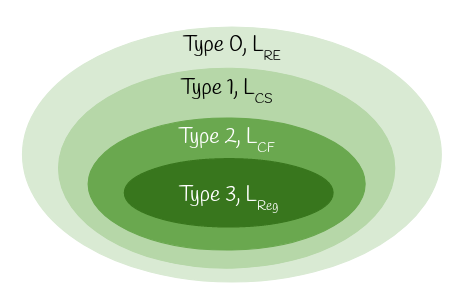
Chomsky Hierarchy
American linguist Noam Chomsky defined in 1956 a classification of languages in terms of four levels of complexity. This four-level hierarchy, called the Chomsky hierarchy, corresponds to four classes of machines [1].
The following table summarizes each of Chomsky's four types of grammars, the class of language it generates, and the type of machine that recognizes it.
| Grammar | Language | Machine |
|---|---|---|
|
Type 0
Unrestricted grammar |
\(L_{\texttt{RE}}\) Recursively enumerable language |
Turing machine (TM) |
|
Type 1
Context-sensitive grammar |
\(L_{\texttt{CS}}\) Context-sensitive language |
Linear-bounded automaton (LBA) |
|
Type 2
Context-free grammar |
\(L_{\texttt{CF}}\) Context-free language |
Pushdown automaton (PDA) |
|
Type 3
Regular grammar |
\(L_{\texttt{Reg}}\) Regular language |
Finite automaton (DFA/NFA) |
Each language of type \(i\) is a proper subset of the family of type \(i − 1\). The following diagram exhibits the relationship clearly:

Reference
-
[1] Linz, Peter. An Introduction to Formal Languages and Automata, 6th Edition. Jones & Bartlett Learning, 2016. ISBN: 9781284077247